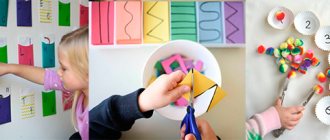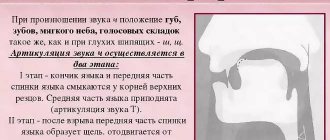Visual and didactic manual on sound automation [C] “Interesting cards”
Galina Kostyuk
Visual and didactic manual on sound automation [C] “Interesting cards”
Automation of assigned sounds is a very important and responsible stage in correctional and speech therapy work to eliminate sound pronunciation disorders. For many children, unfortunately, for various reasons, sounds are very difficult to automate. The use of visualization in correctional work contributes to the formation of children’s interest in classes, and gaming techniques stimulate the mental activity of speech-language pathologist children, thereby contributing to the achievement of the desired results.
I made this manual using the picture designer from the Mersibo development portal. It consists of 4 cards of A-4 format. On the front side there is a house and pictures that “live” in this house. On the reverse side there is a description of the game exercises used in working with this manual. I selected the pictures in such a way that the words did not contain hissing sounds and a minimum of sonorities. Speech therapists and speech pathologists know that this fact contributes to a more successful process of automating whistling sounds.
Visual and didactic aid “Interesting cards”. Automation of sound C.
Target:
Automation of the sound C in words, in sentences; development of phonemic perception, grammatical structure, coherent speech.
Card No. 1 Automation of the sound C at the beginning of a word.
Game exercises:
“Repeaters” The child repeats the names of the pictures after the adult (sun, plane, dog, salad, owl, fireworks, scoop, saxophone, boots, nightingale, catfish, salt shaker, elephant, pig, soup, bough, chest, juice, table, chair, glass, beets, plums).
“Name the object and get a chip” The child names the pictures independently and receives a chip for pronouncing the word correctly.
“Hide and seek” The child closes his eyes, the adult covers several pictures with chips. The child opens his eyes and names the pictures that are “hidden.”
“Name the furniture” (transport, pets, greenery, birds, etc.)
"Who has a tail?" Child: The dog has a tail, etc.
“One is many” 1st child (or adult) - airplane, 2nd child - airplanes, etc.
“What words live in the house?” The adult closes the card, the child names the words that he remembers.
“Telegraph” The child divides words into syllables (claps, taps, lays out with chips).
“Continue the sentence” The adult says the beginning of the sentence, the child finishes. For example: (an airplane is flying high in the sky). Delicious (juice) was poured into a glass. An empty glass was placed on the table, etc.
“What is between, what is” The child makes sentences according to the model: The plane is between the sun and the dog, etc.
“I don’t have something, but I have something” 1st child (or adult) - I have the sun. 2nd child - I don’t have the sun, but I have a plane, etc.
“Make a sentence according to the model” Sample: The owl sleeps during the day, and the nightingale sings, etc.
Card No. 2 Automation of the sound C in the middle of a word
Game exercises:
“Acquaintance” The adult invites the child to get to know the “residents” of the house and determine the common sound in all words, as well as the place of the sound in the words, paying attention to the color of the roof, the letter and the windows.
“Repeat” The child repeats the names of the pictures after the adult (fox, wasp, braids, beans, wheel, mustache, watch, dishes, beads, braid, sand, donkey, swallow, wasps, stork, popsicle, leaf, bridge, football player, cabbage, wheels).
“Name the object and get a chip” The child names the pictures independently and receives a chip for pronouncing the word correctly.
“Name the animals” (birds, insects, garden tools, etc.)
"Who has a tail?" Child: The fox has a tail, etc.
“One is many” 1st child (or adult) is a wasp, 2nd child is a wasp, etc.
“What words live in the house?” The adult closes the card, the child names the words that he remembers.
“Telegraph” The child divides words into syllables (claps, taps, lays out with chips).
“Continue the sentence” The adult says the beginning of the sentence, the child finishes. For example: We saw a cheat (fox) in the forest. Sonya put on her favorite (beads), etc.
“What is between, what is” The child makes sentences according to the model: The wasp is between the fox and the braids, etc.
“I don’t have something, but I have something” 1st child (or adult) - I have a fox. 2nd child - I don’t have a fox, but I have a wasp, etc. “How many wasps (braids?” Child - five wasps, three braids.
“Pick a rhyme” Adult – fox, child – scythe, wasp, etc.
Card No. 3 Automation of the sound C at the end of a word
Gaming techniques:
“Acquaintance” The adult invites the child to get to know the “residents” of the house and determine the common sound in all words, as well as the place of the sound in the words, paying attention to the color of the roof, the letter and the windows.
“Repeaters” The child repeats the names of the pictures after the adult (bus, globe, forest, plus, tray, nose, belt, pineapple, canopy, compass, coconut, oats, vacuum cleaner, ear, focus, ficus, duchess).
“Name the object and get a chip” The child names the pictures independently and receives a chip for pronouncing the word correctly.
“Hide and seek” The child closes his eyes, the adult covers several pictures with chips. The child opens his eyes and names the pictures that are “hidden.”
“Name the transport” (fruits, plants, etc.)
“One is many” 1st child (or adult) - bus, 2nd child - buses, etc.
“What words live in the house?” The adult closes the card, the child names the words that he remembers.
“Telegraph” The child divides words into syllables (claps, taps, lays out with chips).
“Make a sentence” The adult names a word, the child makes a sentence with this word.
“What is between, what is” The child makes sentences according to the model: The globe is between the bus and the forest, etc.
“I don’t have something, but I have something” 1st child (or adult) - I have a bus. 2nd child - I don’t have a bus, but I have a globe, etc.
“Pick a rhyme” Adult – bus, child – globe (tray – coconut, nose, oats, vacuum cleaner), etc.
Card No. 4 Automation of sound C at the beginning, in the middle, at the end of a word
Gaming techniques:
“Repeaters” The child repeats the names of the pictures after the adult (pineapple, stork, clock, plane, wasp, popsicle, juice, tray, dishes, bus, catfish, owl, boots, wheel, dog, pig, forest).
“Name the object and get a chip” The child names the pictures independently and receives a chip for pronouncing the word correctly.
“Hide and seek” The child closes his eyes, the adult covers several pictures with chips. The child opens his eyes and names the pictures that are “hidden.”
“Name the words in which the sound C is at the beginning” (in the middle, at the end)
“Name the transport” (fruits, plants, birds, insects, pets, shoes, etc.)
“One is many” 1st child (or adult) - pineapple, 2nd child - pineapples, etc.
“Telegraph” The child divides words into syllables (claps, taps, lays out with chips).
“Continue the sentence” The adult says the beginning of the sentence, the child finishes using the words from the card. For example: (an airplane is flying high in the sky). Orange juice was poured into (a glass).
“Make a sentence” The adult names a word, the child makes a sentence with this word.
“What is between, what is” The child makes sentences according to the model: The stork is between the pineapple and the clock, etc.
“I don’t have something, but I have something” 1st child (or adult) - I have a pineapple. 2nd child - I don’t have a pineapple, but I have a stork, etc.
“Make sentences based on the model” Sample: The stork flies and the catfish swims. The dog barks and the pig grunts.
Children are happy to study using these cards, they are interested, hence the name “Interesting Cards”.
Games for phonemic perception of sounds С and Сь
Game “Clapping”
Invite your child to clap his hands when he hears S or S in the words. Pronounce words where this sound occurs at the beginning, in the middle and at the end of words and words where S is absent altogether. If it is difficult for a child to hear, extend the sound, for example, masssslo, sssssergi, rysssss.
You can complicate the game and ask the child to clap on the sound C and stamp on S.
Game “What is that whistling, guess”
You will need a picture of a pump and a faucet with water flowing out of it. Show the child the first picture and say: “The air comes out of the soda and whistles S-S-S-S-S-S-S-SC.” Let the baby repeat.
Examples of analysis of educational activities for speech development in preschool educational institutions
Next we show the second picture: “Water flows from the tap and whistles softly, like this.” The child repeats.
Now we show him the pictures one by one and ask him to say how the water whistles.
We give the child pictures and play as follows: you say the sounds mixed together: s-s-s-s-s-s-s-s, and he shows you the correct image. Next, instead of sounds, you can name words where S and Sj occur.
Joke game “Confusion”
Invite your child to guess which words should appear with the sound S or S in the place of the error. For example:
- We ate a robe in the kindergarten. And Mashki is a beautiful salad.
- A bench was flying across the sky. And there was a seagull in the yard.
- They said that a fisherman caught dogs in the river. But then he was hooked by a gnome. (Not a house, but a catfish).
- Vaska is lying on a cot, gnawing on his ears. (Not guns, but dryers).
- The doll's daughter is beautiful! My daughter has a long goat! (not a goat, but a scythe).
Children really like this game, they laugh, but correct mistakes.
Automation of sound
Exercises for automating the sound S: isolated, in syllables, words and sentences.
Automation of the sound of Sya begins with the easiest tasks for the baby.
Sing the “water song.” Say the sound Sya with a smile for a long time, on one exhalation: s-s-s-s...
Repeat straight syllables:
s-s-s-s-s-s-s-s.
Repeat the reverse syllables:
as-os-us-us-is-es-es-es-es-es.
Repeat the syllables where the sound S is between the vowels.
asi-ase-ase-asyu-asya usi-use-use-usyu-usya isi-ise-ise-isyu-isya axis-ose-ose-osyu-osya ysi-yse-yse-ysyu-ysia
Repeat straight syllables with consonant clusters.
sti-ste-sty-stu-sty sleep-spe-spy-spy-spy smi-sme-smo-smy-smy ski-ske-sko-sku-skya snya-sne-sno-snu-snya swee-swe-swe -syu-sya
Repeat the words where the sound S is at the beginning of the word.
Si: Sima, Simone, blue, sitting, sieve, siphon, blue, bruise, radiance, sitting, symphony, shine, blue, turn blue. Behold: hay, seven, family, seed, sowing, Senya, Seva, network, networks, sow, canopy, net, seeds, gray-haired, today, second, sow, family. Sho: Shoma, salmon. Su: suite, here. Xia: sit down, there and there. Confluence of consonants: poems, back, sleeps, snapshot, pig, pig, pork, pig breeder, retinue, wall, wall, flow, Stepan, steppe, snow, snowman, snowfall, laughter, change, sour cream, light, Sveta, shine, scheme , take off.
Repeat the words where the sound S is in the middle of the word.
Asya: Vaska.
Axle: string bag, pug, eighth.
Si: taxi, aspen, aspen, axes, spout, wear, geese, mow, Maxim, boletus, doggie, antennae, barefoot, Osip, bead, bead.
Is: letter.
Behold: autumn, eight, ash, song, songbook, Vasenka, insect, gazebo, hen, cassette, fidget, muslin, pouch, pool, hang.
Yes: braid.
Sho: that's it, ribbon.
Xiu: everywhere.
Sya: Asya, Vasya, goslings, Tosya, joint, oatmeal, ten, grandfather, grandmother, ten, carry, mow, knead.
Repeat the words where the sound S is at the end of the word.
Axis: axis, maybe.
Us: goose.
Ys: heights.
Is: inscription, signature, bend over. Yes: all.
Yus: I’m afraid, I wash myself, I wash myself, I get dressed, I get up.
Repeat words with two S sounds.
Sit down, seventy, lisp, demolish, mixture, laugh, whistle.
Repeat the phrases.
the goose family the eighth house blue ribbon crumpled fabric new suit
blue pouch thin aspen gray-haired grandfather aspen arbor blue bead
autumn day spring sowing steppe geese seven carriages school of geese
Repeat the proverb.
If only this laughter would be for everyone.
Repeat the sentences.
Three words: Asya washes the sieve. Maxim sows seeds. The dog eats sausages. The goose has goslings. Vasya is herding geese. Senya is carrying a letter. The aspen has boletus. Seva sings a song. Pigs eat oatmeal. Maxim walks barefoot.
Four words: Senya blows the whistle. Vasya is on the bus. The pig is sleeping on the hay. Grandma has ten geese. Asya has her mother's cassettes. Goslings are sitting on the hay. There is an inscription on Vasya's cassette. The light shines on the wall. Vasenka the cat is rolling beads. A sieve hangs on the wall. Senya's cat has a mustache. Grandpa has a blue pouch. The pug is sitting in the snow. There are seven sausages in the package. Grandma is sitting under an aspen tree.
Five words. The cat Vaska is sitting on an aspen tree. Today Seva is coming to visit. Asya's window has thin aspen. Vasya the cat walks through the snow. Asya brings home an autumn bouquet. My family is sitting in the gazebo.
Six words. Semyon has a lot of salmon in his nets. Asya and Tosya are traveling in a taxi. A hen sits in the entryway against the wall. Gray-haired grandfather Semyon has a lot of seeds.
Seven words. Neighbor Vasya goes to visit Maxim.
(based on the book by E. N. Spivak, automation of sound S)
Games to automate the sounds S and S using phrases as examples
"Come here"
This game is for several children, but it can also be played in pairs. Before this, just show a small performance with the participation of toys.
Choose toys that have the sound S in their names, for example, a dog, a Sasha doll, an owl, an elephant. Tell us how the toys played this game. For example, a dog says: Doll Sasha, come here! I found you a comb!” The doll Sasha says: “Elephant, come here!” I found you a scooter!” Next, the toy addresses the child, and then the child addresses different toys and says what he found for them. The main thing is that the word must contain S or S'.
Speech per year
"In the shop"
Collect objects and images that have a whistling S or S in them. We have an unusual store; you can only get goods there if you correctly pronounce the name of the product and where it is located. When pronouncing, the child must pronounce the sound we need for a long time. For example:
- Hello! - Hello! What would you like to buy from us? - I want a bowl! – To buy a bowl from us, tell me where the S is in the word? – In the word missssska the sound C is in the middle! - Right! Here's your bowl. - Thank you! Goodbye! - Goodbye! Come to us again!
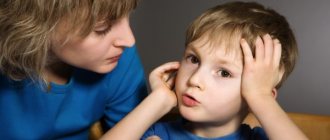

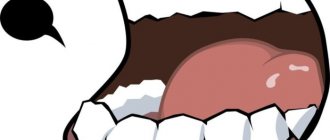
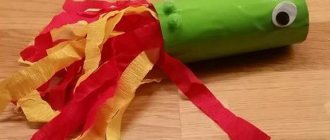
![Producing the sound [L] to a child in stages. Articulation gymnastics, speech therapy exercises, pronunciation lessons with pictures](https://doktorobrubov.ru/wp-content/uploads/postanovka-zvuka-l-rebenku-poetapno-artikulyacionnaya-gimnastika-logopedicheskie-uprazhneniya-uroki-330x140.jpg)
